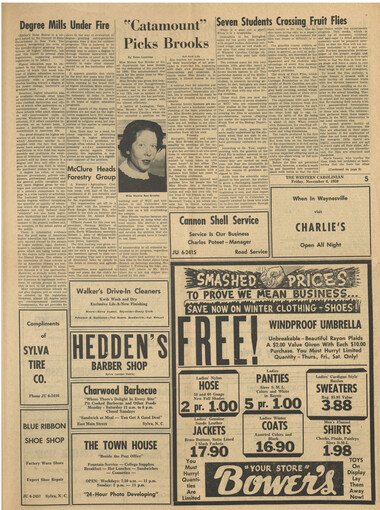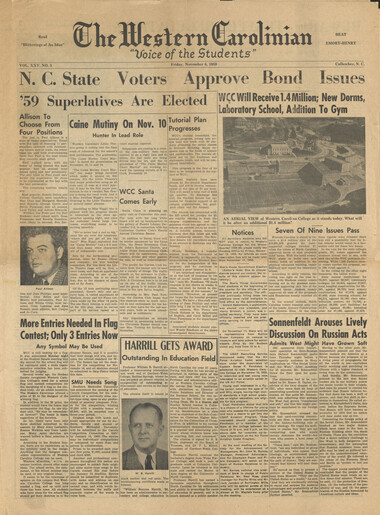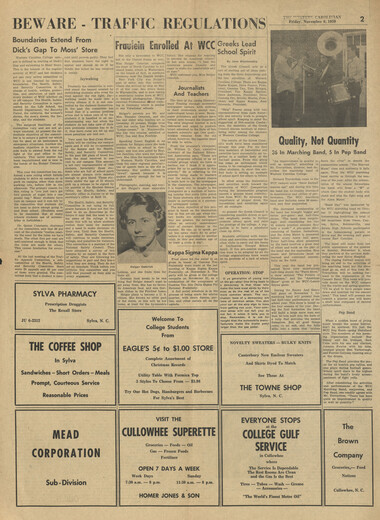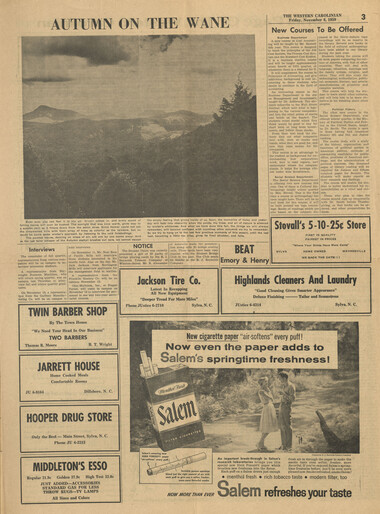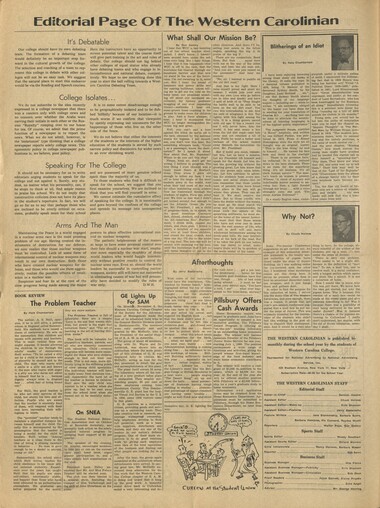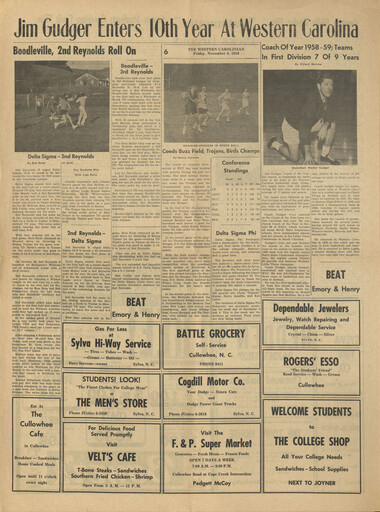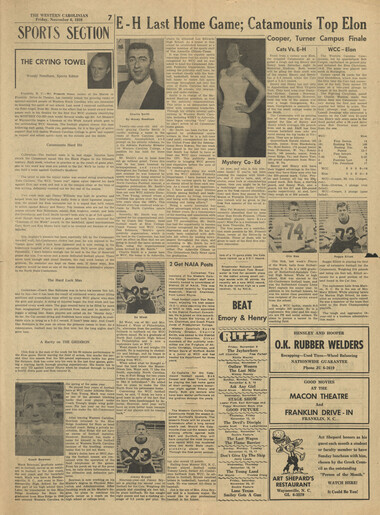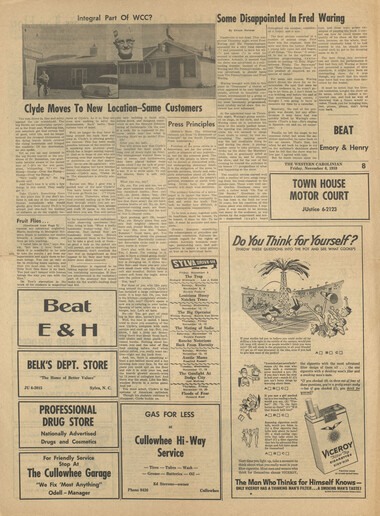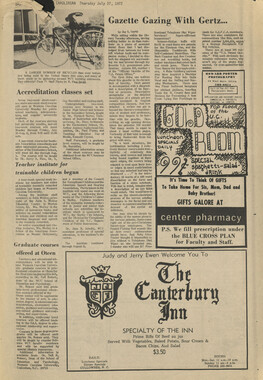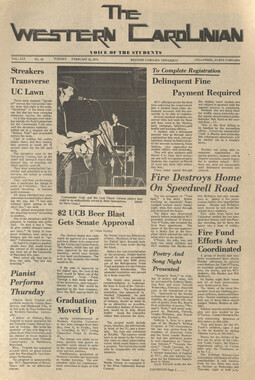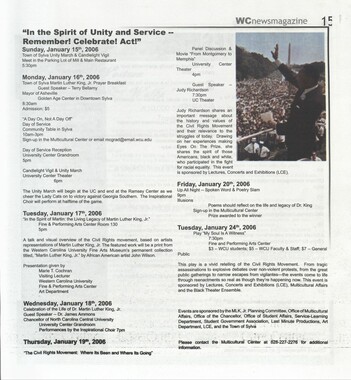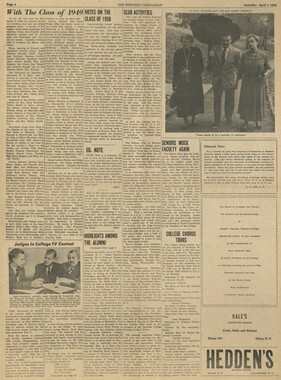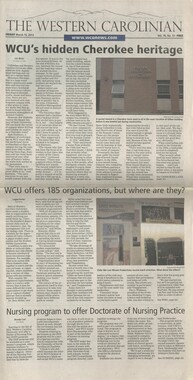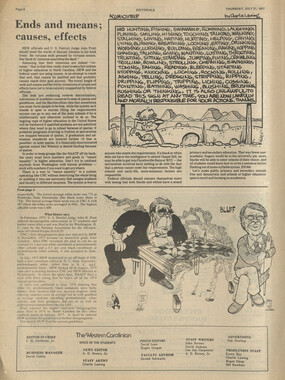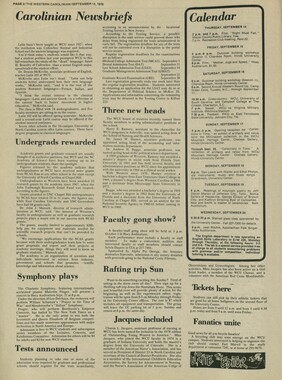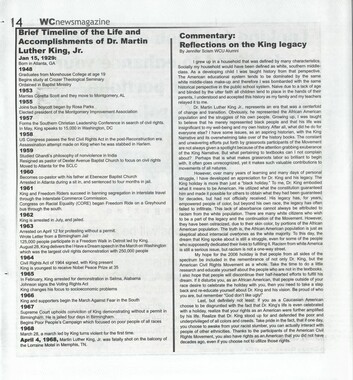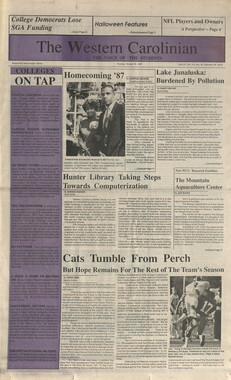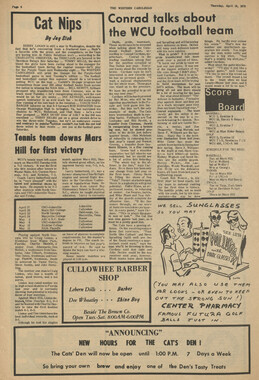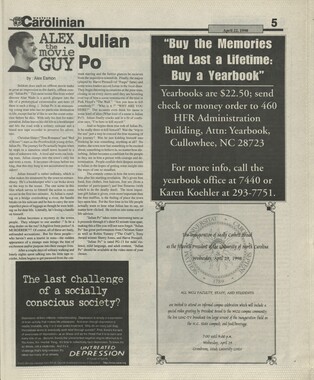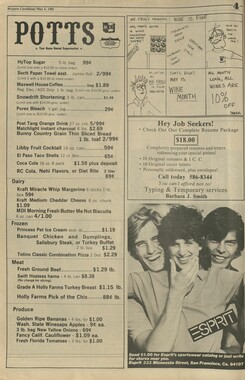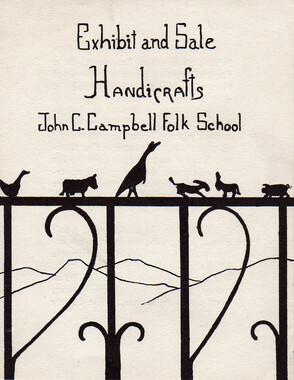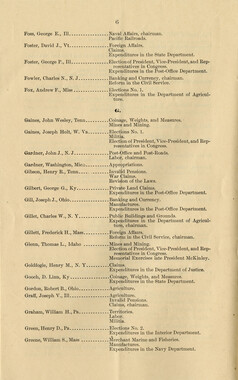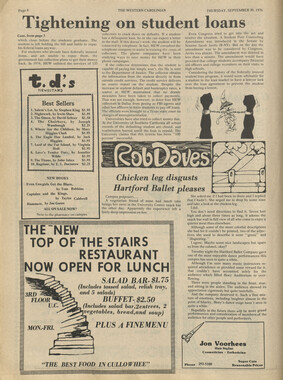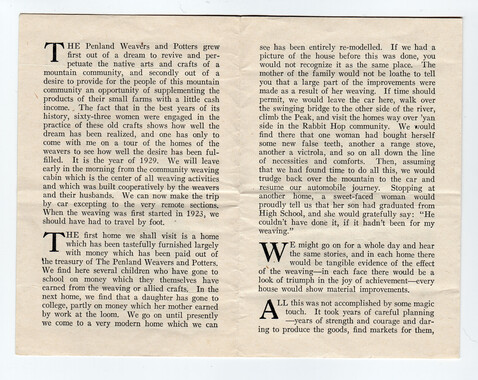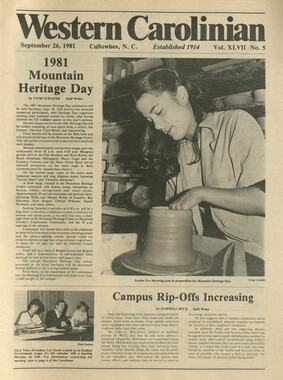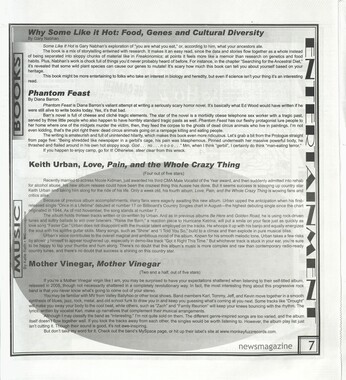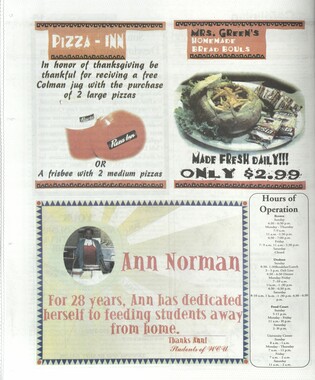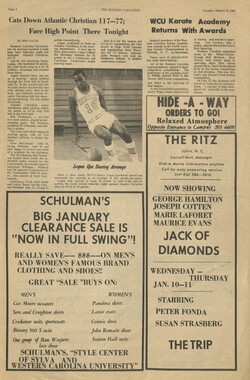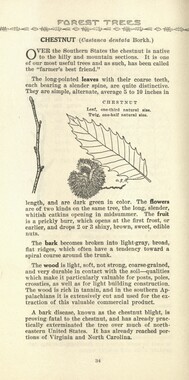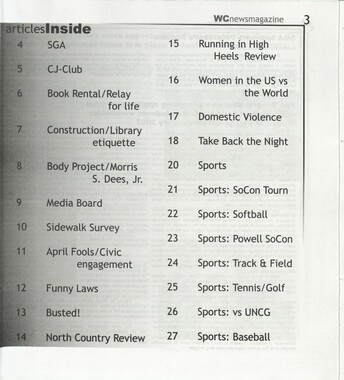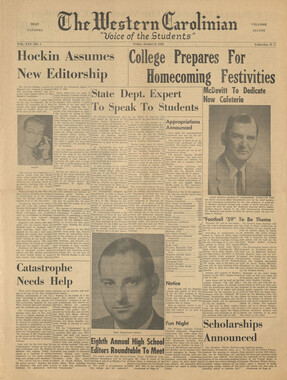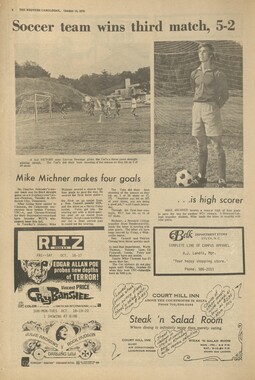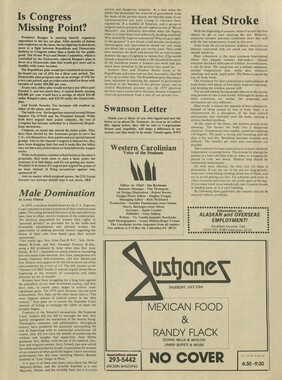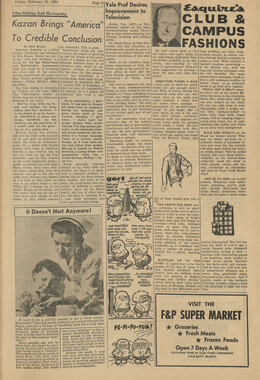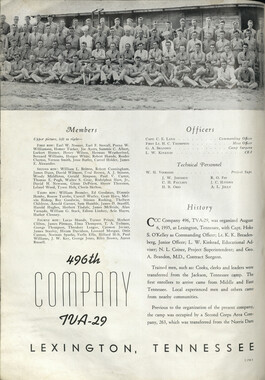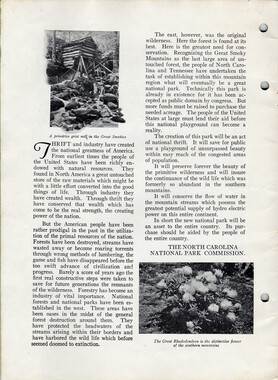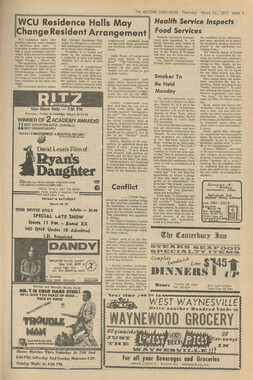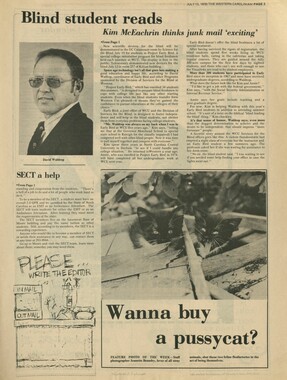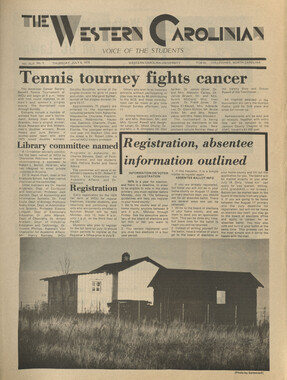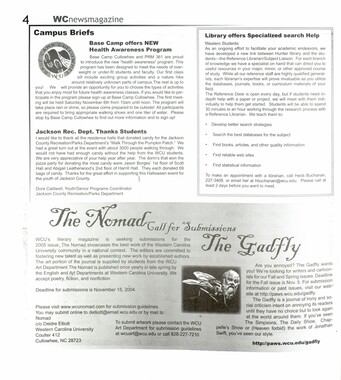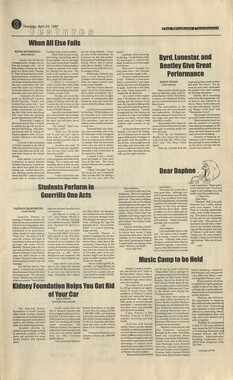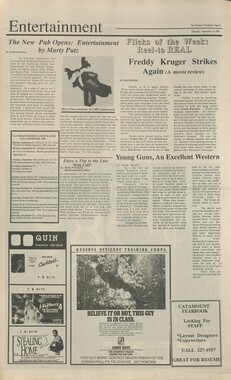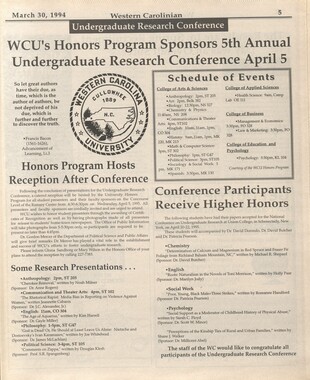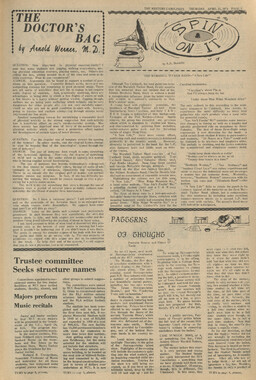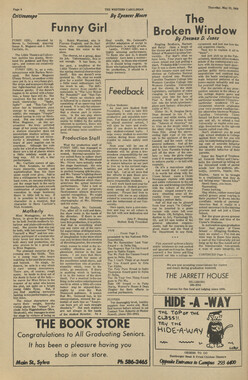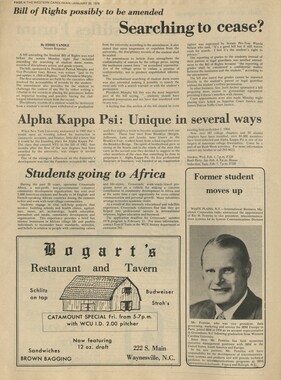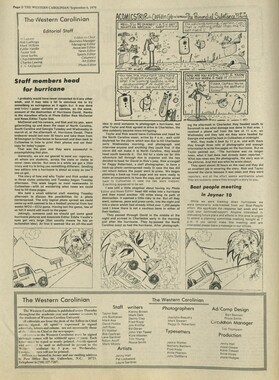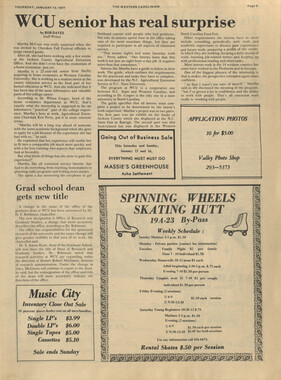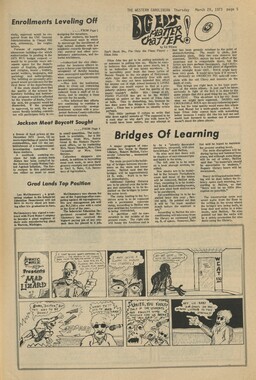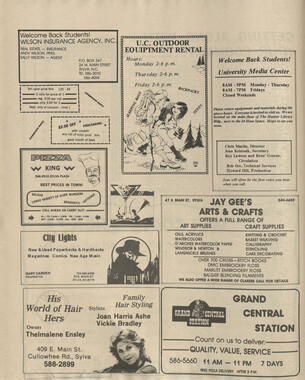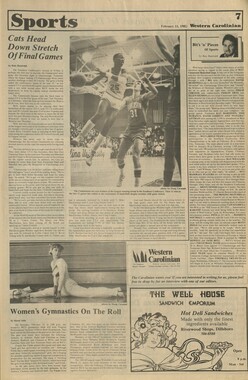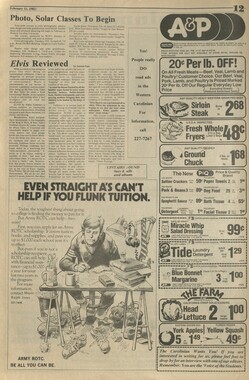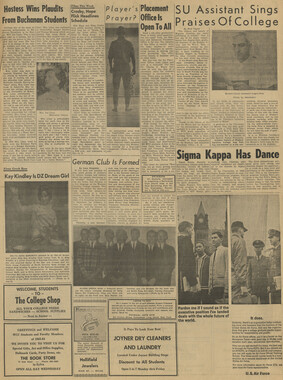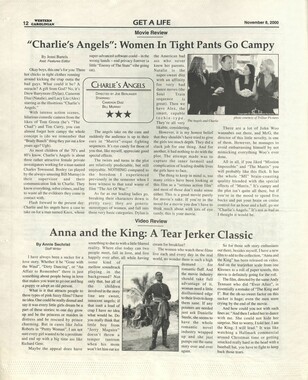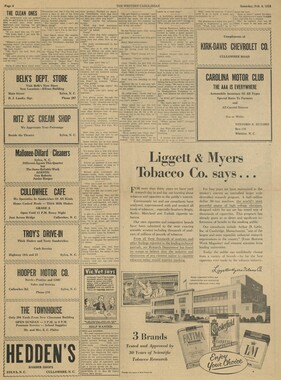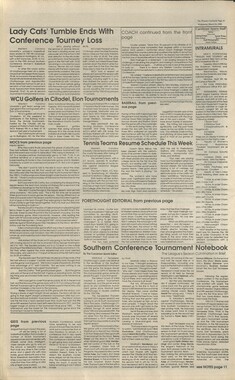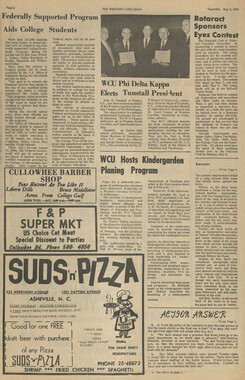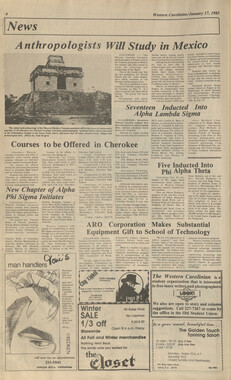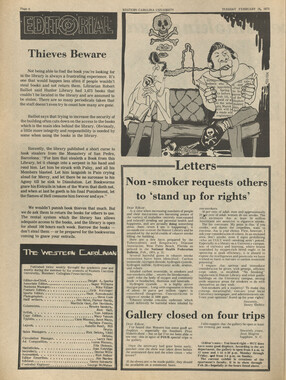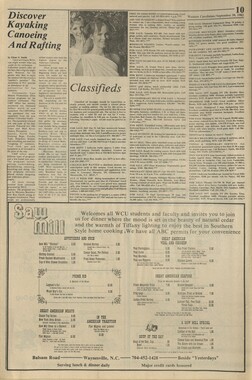Western Carolina University (21)
View all
- Canton Champion Fibre Company (2308)
- Cherokee Traditions (291)
- Civil War in Southern Appalachia (165)
- Craft Revival (1942)
- George Masa Collection (137)
- Great Smoky Mountains - A Park for America (3080)
- Highlights from Western Carolina University (422)
- Horace Kephart (998)
- Journeys Through Jackson (159)
- LGBTQIA+ Archive of Jackson County (89)
- Oral Histories of Western North Carolina (318)
- Picturing Appalachia (6617)
- Stories of Mountain Folk (413)
- Travel Western North Carolina (153)
- Western Carolina University Fine Art Museum Vitreograph Collection (129)
- Western Carolina University Herbarium (92)
- Western Carolina University: Making Memories (738)
- Western Carolina University Publications (2491)
- Western Carolina University Restricted Electronic Theses and Dissertations (146)
- Western North Carolina Regional Maps (71)
- World War II in Southern Appalachia (131)
University of North Carolina Asheville (6)
View all
- Allanstand Cottage Industries (62)
- Appalachian National Park Association (53)
- Bennett, Kelly, 1890-1974 (1463)
- Berry, Walter (76)
- Brasstown Carvers (40)
- Carver, George Washington, 1864?-1943 (26)
- Cathey, Joseph, 1803-1874 (1)
- Champion Fibre Company (233)
- Champion Paper and Fibre Company (297)
- Cherokee Indian Fair Association (16)
- Cherokee Language Program (22)
- Crowe, Amanda (40)
- Edmonston, Thomas Benton, 1842-1907 (7)
- Ensley, A. L. (Abraham Lincoln), 1865-1948 (275)
- Fromer, Irving Rhodes, 1913-1994 (70)
- George Butz (BFS 1907) (46)
- Goodrich, Frances Louisa (120)
- Grant, George Alexander, 1891-1964 (96)
- Heard, Marian Gladys (60)
- Kephart, Calvin, 1883-1969 (15)
- Kephart, Horace, 1862-1931 (313)
- Kephart, Laura, 1862-1954 (91)
- Laney, Gideon Thomas, 1889-1976 (439)
- Masa, George, 1881-1933 (61)
- McElhinney, William Julian, 1896-1953 (44)
- Niggli, Josephina, 1910-1983 (10)
- North Carolina Park Commission (105)
- Osborne, Kezia Stradley (9)
- Owens, Samuel Robert, 1918-1995 (11)
- Penland Weavers and Potters (36)
- Roberts, Vivienne (15)
- Roth, Albert, 1890-1974 (142)
- Schenck, Carl Alwin, 1868-1955 (1)
- Sherrill's Photography Studio (2565)
- Southern Highland Handicraft Guild (127)
- Southern Highlanders, Inc. (71)
- Stalcup, Jesse Bryson (46)
- Stearns, I. K. (213)
- Thompson, James Edward, 1880-1976 (226)
- United States. Indian Arts and Crafts Board (130)
- USFS (683)
- Vance, Zebulon Baird, 1830-1894 (1)
- Weaver, Zebulon, 1872-1948 (58)
- Western Carolina College (230)
- Western Carolina Teachers College (282)
- Western Carolina University (2008)
- Western Carolina University. Mountain Heritage Center (18)
- Whitman, Walt, 1819-1892 (10)
- Wilburn, Hiram Coleman, 1880-1967 (73)
- Williams, Isadora (3)
- Cain, Doreyl Ammons (0)
- Crittenden, Lorraine (0)
- Rhodes, Judy (0)
- Smith, Edward Clark (0)
- Appalachian Region, Southern (3032)
- Asheville (N.C.) (1945)
- Avery County (N.C.) (26)
- Blount County (Tenn.) (195)
- Buncombe County (N.C.) (1680)
- Cherokee County (N.C.) (283)
- Clay County (N.C.) (556)
- Graham County (N.C.) (238)
- Great Smoky Mountains National Park (N.C. and Tenn.) (535)
- Haywood County (N.C.) (3573)
- Henderson County (N.C.) (70)
- Jackson County (N.C.) (4925)
- Knox County (Tenn.) (35)
- Knoxville (Tenn.) (13)
- Lake Santeetlah (N.C.) (10)
- Macon County (N.C.) (421)
- Madison County (N.C.) (216)
- McDowell County (N.C.) (39)
- Mitchell County (N.C.) (135)
- Polk County (N.C.) (35)
- Qualla Boundary (982)
- Rutherford County (N.C.) (78)
- Swain County (N.C.) (2185)
- Transylvania County (N.C.) (270)
- Watauga County (N.C.) (12)
- Waynesville (N.C.) (86)
- Yancey County (N.C.) (72)
- Aerial Photographs (3)
- Aerial Views (60)
- Albums (books) (4)
- Articles (1)
- Artifacts (object Genre) (228)
- Bibliographies (1)
- Biography (general Genre) (2)
- Cards (information Artifacts) (38)
- Clippings (information Artifacts) (193)
- Copybooks (instructional Materials) (3)
- Crafts (art Genres) (622)
- Depictions (visual Works) (21)
- Design Drawings (1)
- Digital Moving Image Formats (2)
- Drawings (visual Works) (185)
- Envelopes (115)
- Exhibitions (events) (1)
- Facsimiles (reproductions) (1)
- Fiction (general Genre) (4)
- Financial Records (12)
- Fliers (printed Matter) (67)
- Glass Plate Negatives (381)
- Guidebooks (2)
- Internegatives (10)
- Interviews (823)
- Land Surveys (102)
- Letters (correspondence) (1070)
- Manuscripts (documents) (618)
- Maps (documents) (177)
- Memorandums (25)
- Minutes (administrative Records) (59)
- Negatives (photographs) (6090)
- Newsletters (1290)
- Newspapers (2)
- Notebooks (8)
- Occupation Currency (1)
- Paintings (visual Works) (1)
- Pen And Ink Drawings (1)
- Periodicals (194)
- Personal Narratives (10)
- Photographs (12977)
- Plans (maps) (1)
- Poetry (6)
- Portraits (4568)
- Postcards (329)
- Programs (documents) (181)
- Publications (documents) (2444)
- Questionnaires (65)
- Relief Prints (26)
- Sayings (literary Genre) (1)
- Scrapbooks (282)
- Sheet Music (2)
- Slides (photographs) (402)
- Songs (musical Compositions) (2)
- Sound Recordings (802)
- Specimens (92)
- Speeches (documents) (18)
- Tintypes (photographs) (8)
- Transcripts (329)
- Text Messages (0)
- A.L. Ensley Collection (275)
- Appalachian Industrial School Records (7)
- Appalachian National Park Association Records (336)
- Axley-Meroney Collection (2)
- Bayard Wootten Photograph Collection (20)
- Bethel Rural Community Organization Collection (7)
- Blumer Collection (5)
- C.W. Slagle Collection (20)
- Canton Area Historical Museum (2110)
- Carlos C. Campbell Collection (462)
- Cataloochee History Project (64)
- Cherokee Studies Collection (4)
- Daisy Dame Photograph Album (5)
- Daniel Boone VI Collection (1)
- Doris Ulmann Photograph Collection (112)
- Elizabeth H. Lasley Collection (1)
- Elizabeth Woolworth Szold Fleharty Collection (4)
- Frank Fry Collection (95)
- George Masa Collection (173)
- Gideon Laney Collection (452)
- Hazel Scarborough Collection (2)
- Hiram C. Wilburn Papers (28)
- Historic Photographs Collection (236)
- Horace Kephart Collection (861)
- Humbard Collection (33)
- Hunter and Weaver Families Collection (1)
- I. D. Blumenthal Collection (4)
- Isadora Williams Collection (4)
- Jesse Bryson Stalcup Collection (47)
- Jim Thompson Collection (224)
- John B. Battle Collection (7)
- John C. Campbell Folk School Records (80)
- John Parris Collection (6)
- Judaculla Rock project (2)
- Kelly Bennett Collection (1482)
- Love Family Papers (11)
- Major Wiley Parris Civil War Letters (3)
- Map Collection (12)
- McFee-Misemer Civil War Letters (34)
- Mountain Heritage Center Collection (4)
- Norburn - Robertson - Thomson Families Collection (44)
- Pauline Hood Collection (7)
- Pre-Guild Collection (2)
- Qualla Arts and Crafts Mutual Collection (12)
- R.A. Romanes Collection (681)
- Rosser H. Taylor Collection (1)
- Samuel Robert Owens Collection (94)
- Sara Madison Collection (144)
- Sherrill Studio Photo Collection (2558)
- Smoky Mountains Hiking Club Collection (616)
- Stories of Mountain Folk - Radio Programs (374)
- The Reporter, Western Carolina University (510)
- Venoy and Elizabeth Reed Collection (16)
- WCU Gender and Sexuality Oral History Project (36)
- WCU Mountain Heritage Center Oral Histories (25)
- WCU Oral History Collection - Mountain People, Mountain Lives (71)
- WCU Students Newspapers Collection (1923)
- Western North Carolina Tomorrow Black Oral History Project (69)
- William Williams Stringfield Collection (2)
- Zebulon Weaver Collection (109)
- African Americans (390)
- Appalachian Trail (35)
- Artisans (521)
- Cherokee art (84)
- Cherokee artists -- North Carolina (10)
- Cherokee language (21)
- Cherokee pottery (101)
- Cherokee women (208)
- Church buildings (190)
- Civilian Conservation Corps (U.S.) (111)
- College student newspapers and periodicals (2012)
- Dams (108)
- Dance (1023)
- Education (222)
- Floods (63)
- Folk music (1015)
- Forced removal, 1813-1903 (2)
- Forest conservation (220)
- Forests and forestry (1198)
- Gender nonconformity (4)
- Great Smoky Mountains National Park (N.C. and Tenn.) (181)
- Hunting (47)
- Landscape photography (25)
- Logging (122)
- Maps (83)
- Mines and mineral resources (9)
- North Carolina -- Maps (18)
- Paper industry (38)
- Postcards (255)
- Pottery (135)
- Railroad trains (72)
- Rural electrification -- North Carolina, Western (3)
- School integration -- Southern States (2)
- Segregation -- North Carolina, Western (5)
- Slavery (5)
- Sports (452)
- Storytelling (243)
- Waterfalls -- Great Smoky Mountains (N.C. and Tenn.) (66)
- Weaving -- Appalachian Region, Southern (280)
- Wood-carving -- Appalachian Region, Southern (328)
- World War, 1939-1945 (174)
Western Carolinian Volume 25 Number 05
Item
Item’s are ‘child’ level descriptions to ‘parent’ objects, (e.g. one page of a whole book).
-
-
Degree Mills Under Fire (Editor's Note: Below is a report issued by the Council of State Government in New York. The Council, recognizing the evils of the pseudo-degree granting institutions of higher education, has sent this report to several state legislatures, suggesting possible legislation to be taken.) Higher education may be obtained " in the United States in a variety of ways. Our usual concept of higher education involves resident instruction at a college or university with a program of studies leading toward a degree at the junior college, bachelor's or graduate level. However, higher education also is available through other types of institutions, some of which provide resident instruction and others of which offer instruction on a correspondence basis. Many of these schools offer adult education or self - improvement types of courses. Whatever the type of institution, if it offers competent instruction on an honest basis, it makes a practical and cultural contribution to American life. The great demand for higher education of all types and the value which Americans ascribe to it coupled with the fact that most states have adopted only minimal regulations in this field has made possible and profitable the existence of fradulent institutions. The product sold by these schools is a degree and they will offer a degree in almost any field in which the purchaser wishes to have one. A degree has value, of course, because government, private employers, professional societies and the general public recognize and rely upon degrees given by colleges and universities as evidence of a person's competence to engage in a wide variety of activities. The fradulent institutions which confer degrees without furnishing the quantity or quality of education which the degree purports to evidence not only defraud their "students" but also harm legitimate institutions and their alumni and may constitute a substantial menace to the general welfare and, on occasion, to the actual safety of the public. There is substantial evidence that the good name of American higher education has been materially injured abroad by the stream of bogus medical, legal, doctoral, master's, bachelor's, and other degrees which are being turned out by the degree mills located within the United States. The effects of the operations of these schools as far as American citizens are concerned is more difficult to measure because it is less spectacular. However, as already noted, fraudulent practices in higher education are injurious to legitimate institutions, to various groups in society and, in fact, to the general public. Most correspondence schools do not give degrees and so would not be covered by the legislation. However, almost all degree mills are correspondence institutions. Consequently, the act provides for more in the way of evaluation of degree - granting correspondence programs than it does for resident programs. This is believed to be justified on the ground that the normal way to secure a degree is through resident instruction and that the-burden of proof as to the legitimacy of a degree obtained entirely in some other manner should be on the institution offering it. It appears possible that states in the next few years may find it desirable to adopt additional legislation relating to the broad field of higher education. More comprehensive controls over the quality of education offered may prove to be necessary in order to insure that minimum standards are met in all types of higher education programs. Some aspects of the degree mill problem are not met by the legislation suggested here. For example, many questionable degrees are granted in religious areas, but regulation of this matter is exempted from this proposal. Also, there may be a need for closer regulation of advertising practices in higher education. However, these problems, although often related to the matter presently under consideration, present special aspects. Consequently, this legislation is suggested as an approach to a significant segment of the problem. "Catamount" $even Students Crossing Fruit Flies ^^-^w*- ^ %-%•-■"■--»1-V-^ •^■..■—M. %,■ wh»n is a mat not a mat' thpir results to Dr. Yow. who in- can thrive while thi Picks Brooks By Gene Lominac Miss Mamie Rae Brooks of the art department has been chosen for the dedication of the yearbook for 1960. The announcement was made for the senior class by Marti Smathers, editor. Miss Brooks was given this honor because of her thoughtfulness and devotion to teaching, to the students, and to the school. This is her 12th year as sponsor of the annual, a service she has performed consistently and always with the utmost efficiency. A native of Lexington, Tenn., Miss Brooks fell in love with Western North Carolina when she first accepted a position on the McClure Heads Forestry Group A Forestry - Agriculture Club was formed at Western Carolina this week, with half of the total enrollment of 61 pre-forestry and pre-agriculture students present for the organization. The organization got off to a good start with the presence of Park Ranger Norman Roy, who talked to the club on forestry and conservation. Dr. Arnold Kroch- mal is faculty sponsor. Officers chosen for this year are: president, Norman McClure of Alexis; vice president, Dale Bran- nock, North Wilkesboro; secretary, Robert I. Isley of McLeansville; treasurer, Evan Kirby, 320 West- over Drive, Asheville. The first meeting was given over to discussion of suitable activities for such a club, during which the members agreed to plan several camping trips and a program of illustrated talks by people in the fields of forestry and agriculture. Committees were appointed to map out plans for the club's future. The club extended a welcome Miss Mamie Rae Brooks teaching stall of WCC and now prefers to call Cullowhee her home. The new house she recently built rests on a hill overlooking the campus. Miss Brooks teaches because she firmly believes in doing what she most enjoys. She derives a great satisfaction from watching her students progress in their work and develop the abilities that she professes all people have if taught to use them. Art And Life She teaches her students to apply their knowledge of art principles to everyday life, beginning with their own personal habits, observations and selections. A course under Miss Brooks is, in essence, a liberal course in humanity. A natrual flair for selection and appropriateness in dress attests to her qualification. Impeccably stylish, she is considered by many to be the ebst dressed woman on the campus. Because future teachers are expected to have a workable understanding of the basic principles of art, Miss Brooks probably sees, in a years' time, the majority of the student body. However, her contacts are not limited to the classroom. She takes a personal interest in every student she meets, and considers them all her own. , Friendly Energetic, friendly and expansive, Miss Brooks allows her personality to envelope all her acquaintances, and her willingness to give her services to all who need them is unsurpassed on the campus. Any of her free hours are subject to being taken up with "open house" in her office. The more traffic, the better she likes it, rising to the occasion with a radiance that belies her years in the teaching profession. This inexhaustible interest and genuine love for people has led Miss Brooks into a fascinating summertime employment that enriches not only her own life, but the lives of her friends as well. She serves as tour director for Brownell Tours, a job which permits her to travel extensively throughout Europe and Asia. Her When is a gnat not a gnat When it is a drosophila. Drosophila is the biological name for the pretty little insects with striped bodies, delicately outlined wings, and an odd shade of red eyes that some students here at Western Carolina College observe when they peer into their microscopes. The common name for this very common little gnat-like insect is Fruit Fly. There are about 22 different known species in all. This particular species is of the Mediterranean variety, and the most studied, in research involving genetics. In fact, biologists are more familiar with the genetics of the Fruit Fly than with any other living creature. These fruit flies are now the primary concern of seven students at WCC who are concentrating their studies in the science field. The experiments that involve crossing the flies to establish and pre-determine various offspring are under the supervision of Dr. Frank Yow of the Biology Department. A difficult study, genetics are more easily understood by the students when they are able to see, step by step, the results that they have previously calibrated on paper. According ot Dr. Yow, experimenting with the genetics of the Fruit Fly is neither unusual in the biological world, nor to WCC, where they are carried on each year, but they are invaluable in that the student may see for himself the results of problems assigned to him. Aside from the scientific value gained in this pursuit, the student is given a challenging opportunity to think. The students are required to do all their own work from beginning to end, and then report their results to Dr. Yow, who in sists upon acting only as a supervisor, although the excitement the flies can create is difficult to e- lude. The genetics course consists of three lectures a week in which ge- nitics in general, as well as anticipated results, are discussed by the instructor. The lab periods are independent and the students take advantage of every free moment they have to use in studying their assigned problems. The stock of Fruit Flies, which come to WCC from either the Carnegie Foundation or the University of North Carolina, are primarily of one kind—those having grey body covering, normal wings, and either red, eosin or white eyes. These are know as wild flies. The experiment with each stock supply of flies involves from five to six separate problems for each individual in the class. Generally, the steps from egg to egg, i.e., from the birth of the fly being studied to her own laying period, is about 12 days. When crossed with themselves, the resulting offspring should be uniform in size, color and wing dimensions. The results produced in the first generation are of wild expression. But from then on the fascination of the experiments is in full swing, for the different crosses that can be effected produce any of the various expected offspring such as white eye-short wing, or red eye- vestigial wing, etc. Before the flies are permitted to breed, however, a media is made up and deposited into numerous small milk bottle so that the flies return each fall to Cullowhee is eagerly awaited by those who wish to re-live her experiences through her animated accounts. to membership to all stduents interested in its program, regardless of their major fields. The club's first activity is a nature hike in the forest above Long Branch on Saturday morning, November 7. Following the hike, students will return to Mr. Hirt's place for a hot dog dinner prepared by the club. Cannon Shell Service Service Is Our Business Charles Poteet - Manager JU 6-2415 Road Service can thrive while the experiments progress. This media, which is made up of molasses, cornmeal and agar-agar (a dried gelatinous material) must be prepared carefully so that the flies will not become embedded in it and suffocate. Further preparation involve/ paper of the proper weight and absorbency which is placed in each bottle so that the flies in their pupa stage will have a place to rest after they emerge and wait for their wings to dry and strengthen. To breed the flies initially, a virgin female is crossed with a male having all dominant traits with few obvious recessive traits. The students carrying on the experiments nave formulated ratios prior to the actual breeding. Theoretically, they know what results to expect and the approximate ratios. By checking their results with the preconveived formulations they either verify their conclusions or draw new ones. The information gathered from these experiments in the WCC laboratories is not used anywhere else. To permit greater facility of study under the microscope, the flies are etherized in their separate bottles. If the application of ether has not been strong enough, the energetic little insects are highly uncooperative and are apt to crawl right off their slides. After the experiments are discontinued, the flies are etherized and discarded. Marie Searcy, who typifies the class, finds her problems so fascinating that she fears her other (Continued on page 8) THE WESTERN CAROLINIAN Friday, November 6, 1959 When In Waynesville visit CHARLIE'S Open All Night Compliments of SYLVA TIRE CO. Phone JU 6-2416 Walker's Drive-In Cleaners Kwik Wash and Dry- Exclusive Lik-A-New Finishing Moore—Belva Austell, Reynolds—Denny Croft Roberson & Buchanan—Ted Moore. Boodleville—Hal Metcalf KEDDEN'S BARBER SHOP Sylva (under Velt's) TO PROVE WE MEAN BUSiNESS- ^AAtA jjitg Ijjjf .%;'■'■ SAVE NOW ON WINTER CLOTHING- - SHOES! WINDPR00F UMBRELLA Unbreakable - Beautiful Rayon Plaids A $2.00 Value Given With Each $10.00 Purchase. You Must Hurry! Limited Quantity - Thurs., Fri., Sat. Only! BLUE RIBBON SHOE SHOP Factory Worn Shoes Expert Shoe Repair JU 6-2457 Sylva, N. C. Charwood Barbecue "Where There's Delight In Every Bite" Pit Cooked Barbecue and Other Foods Monday - Saturday 11 a.m. to 8 p.m. Closed Sundays "Sandwich or Meal — You Get A Good Deal" East Main Street Sylva, N. C. THE TOWN HOUSE "Beside the Post Office" Fountain Service — College Supplies Breakfast — Hot Lunches — Sandwiches — Cosmetics — OPEN: Weekdays: 7:30 a.m. — 11 p.m. Sunday: 2 p.m. — 11 p.m. "24-Hour Photo Developing" Ladies PANTIES Sizes S. M. L. Colors and White in Rayon 5 pr. 100 Ladies' Genuine Suede Leather JACKETS Brass Buttons, Satin Lined 2 Slash Pockets 17-90 You Must Hurry! Quantities Are Limited Ladies Winter COATS Assorted Colors and Black 16-90 Ladies' Cardigan Style Banlon SWEATERS Reg. $5.95 Value Men's Flannel SHIRTS Checks, Plaids, Paisleys Sizes S-M-L 198 TOYS On Display Lay Them Away Now!
Object
Object’s are ‘parent’ level descriptions to ‘children’ items, (e.g. a book with pages).
-
The Western Carolinian is Western Carolina University’s student-run newspaper. The paper was published as the Cullowhee Yodel from 1924 to 1931 before changing its name to The Western Carolinian in 1933.
-
